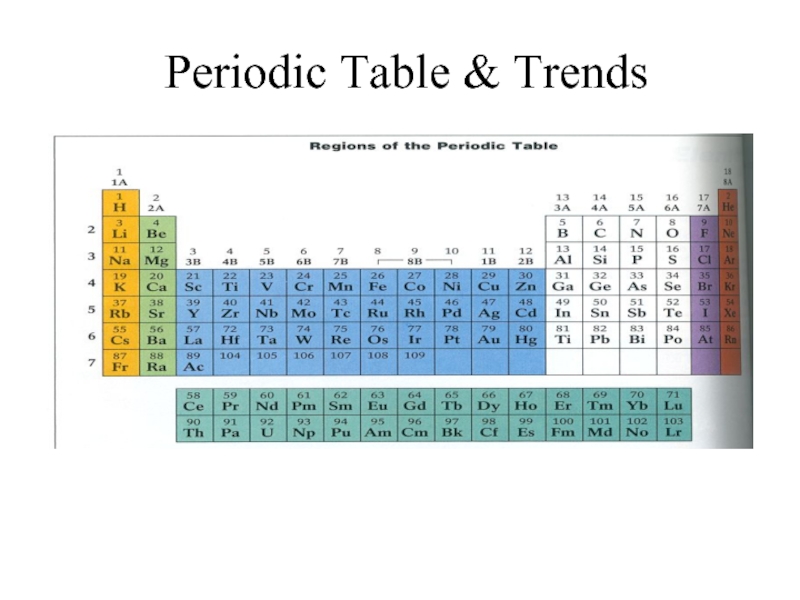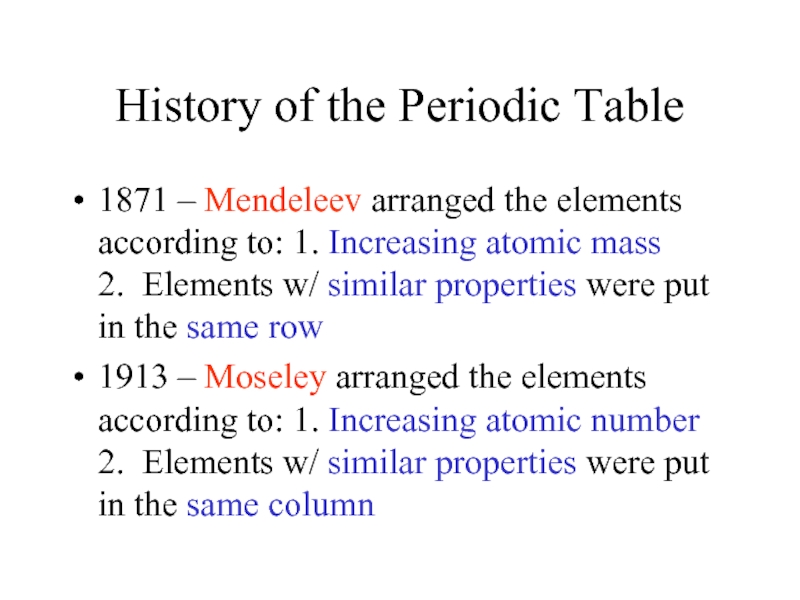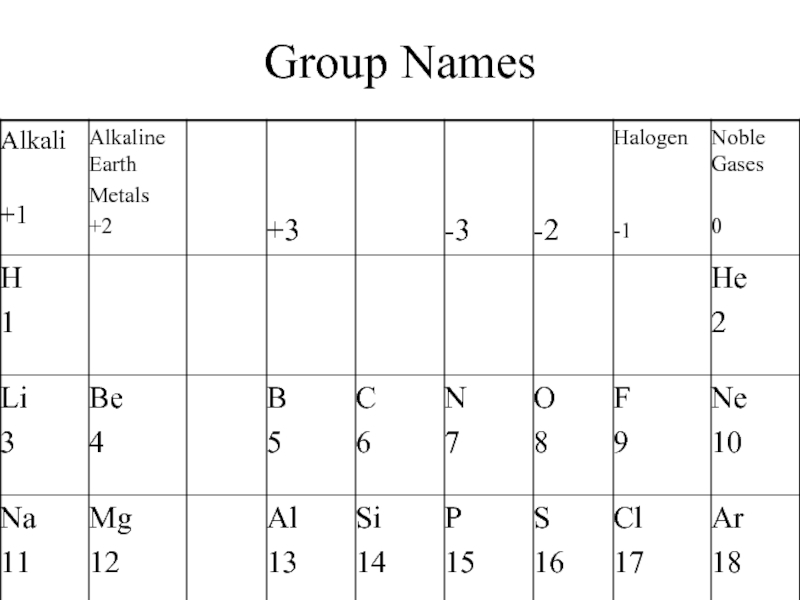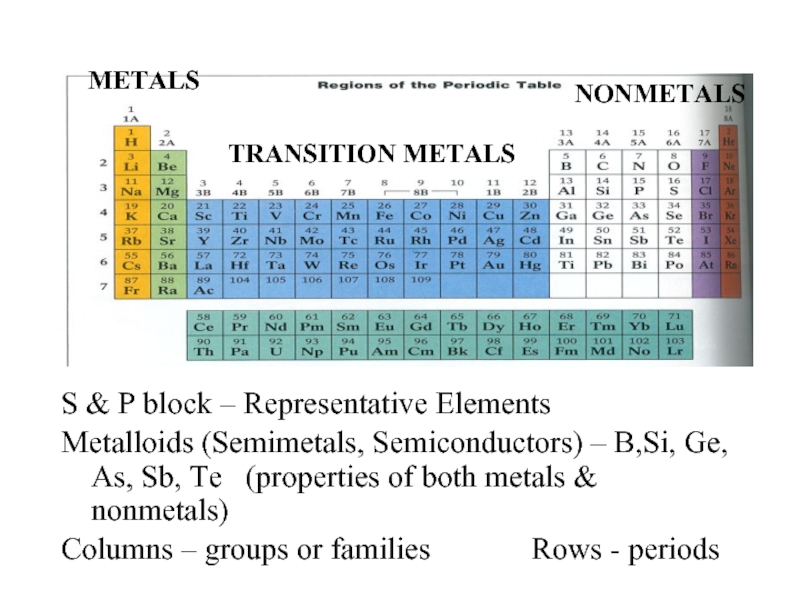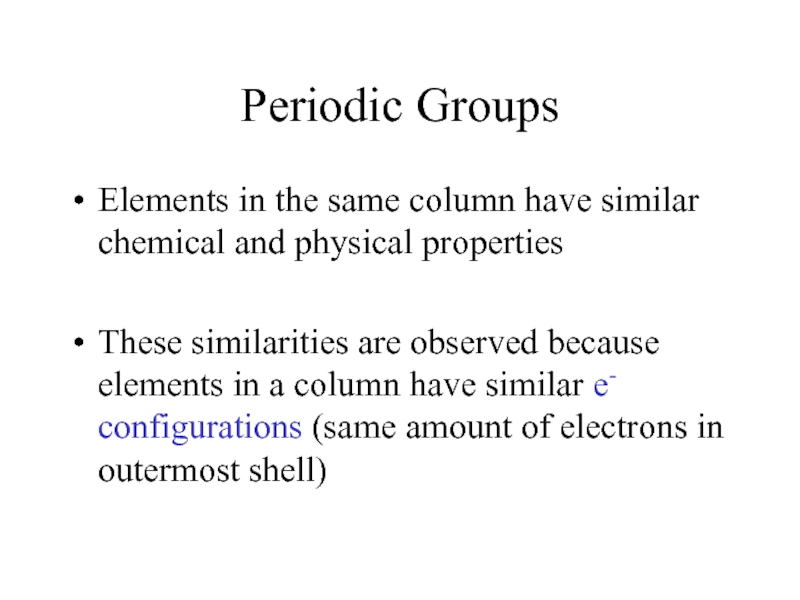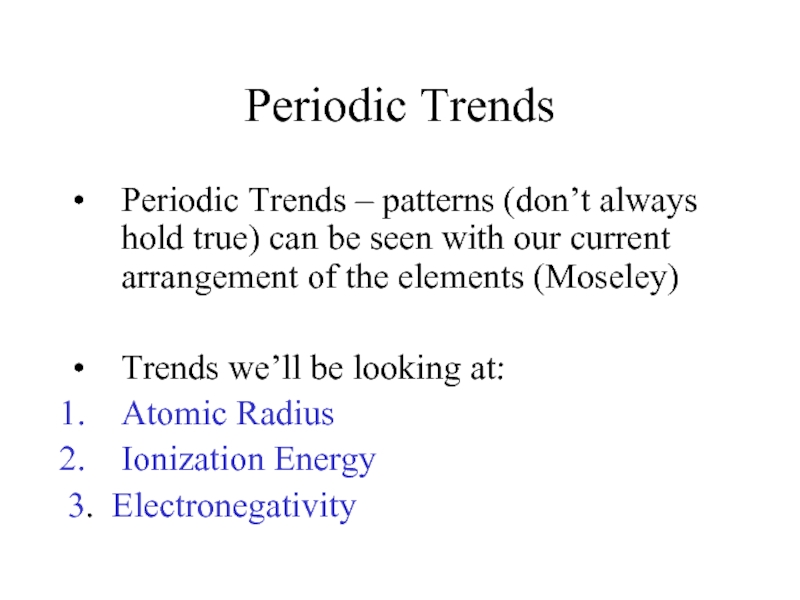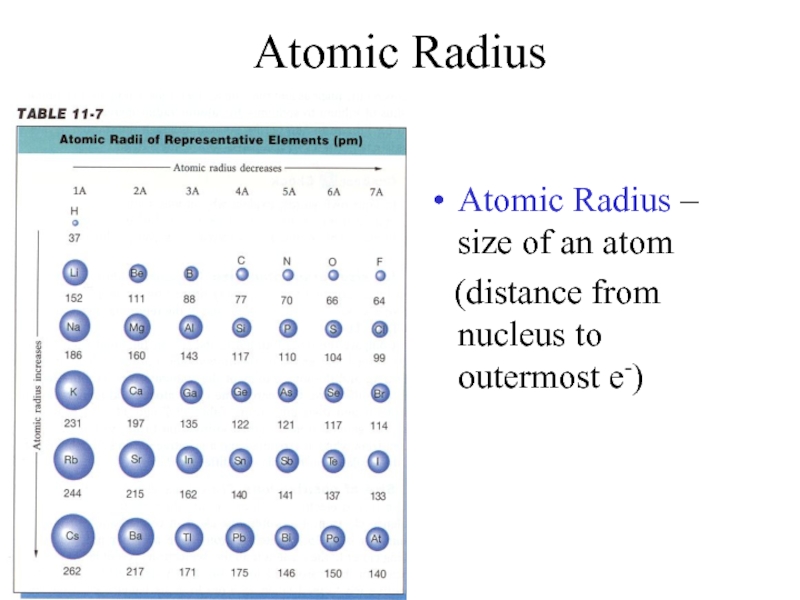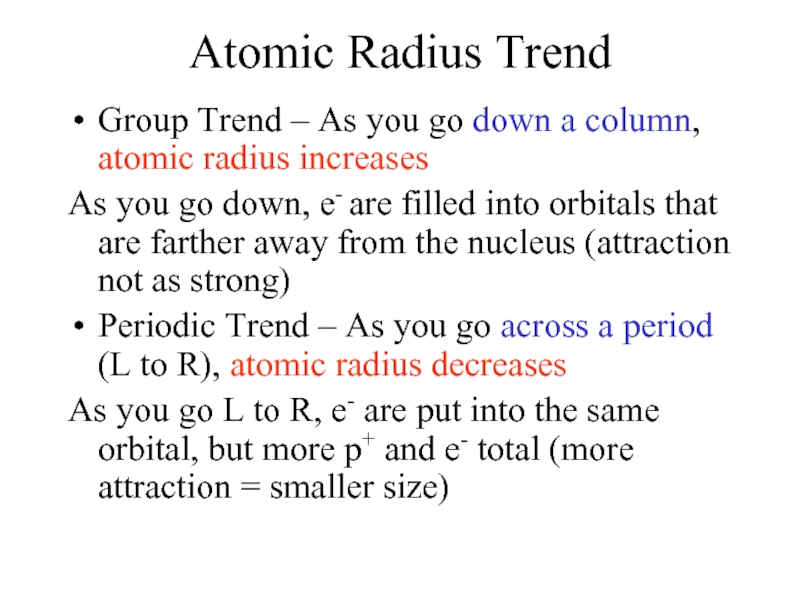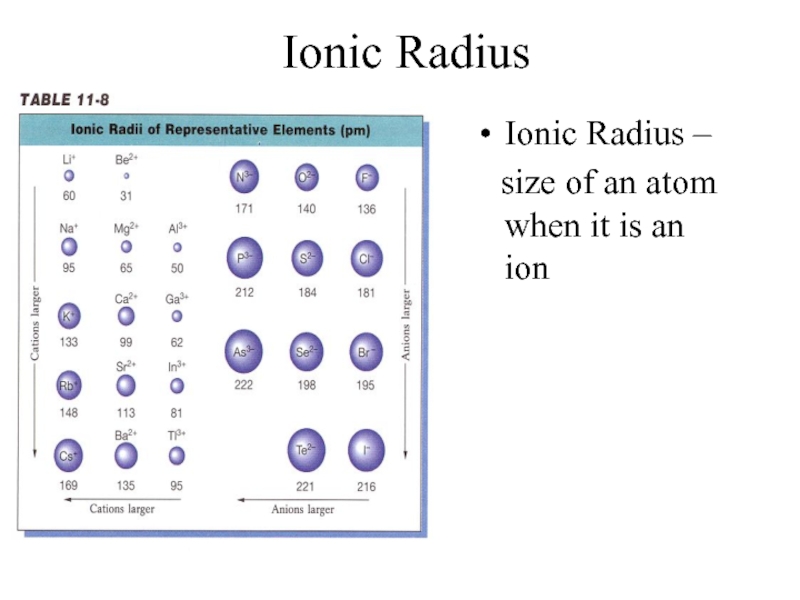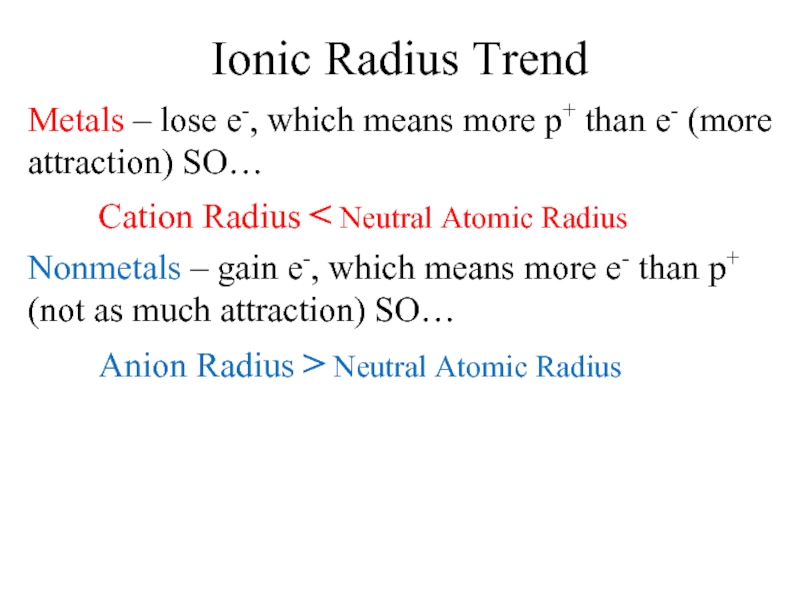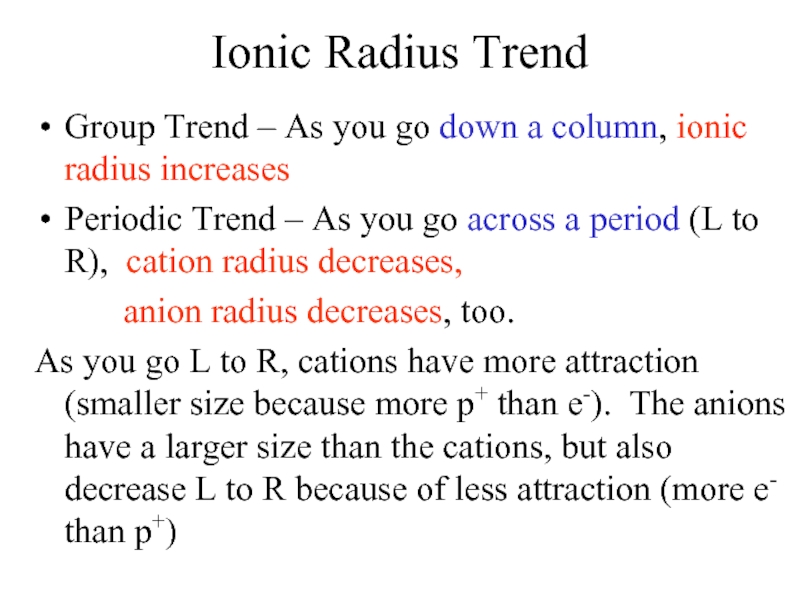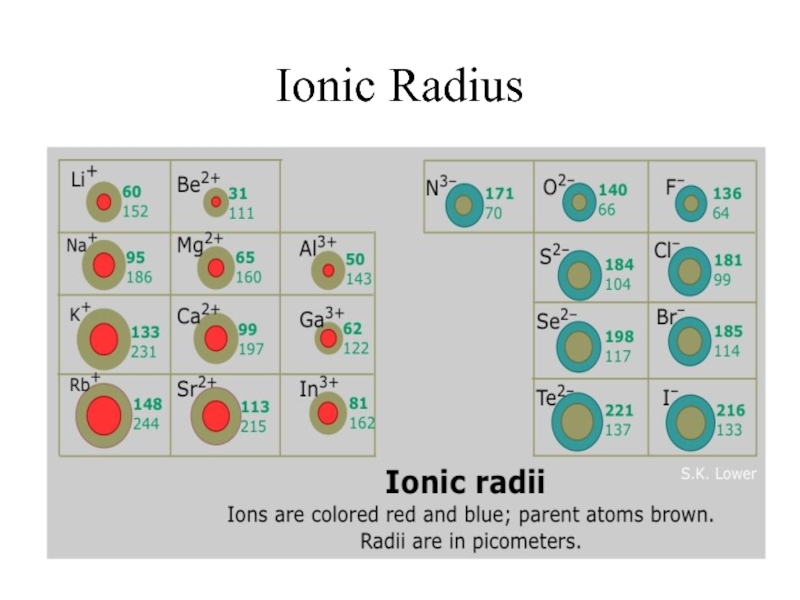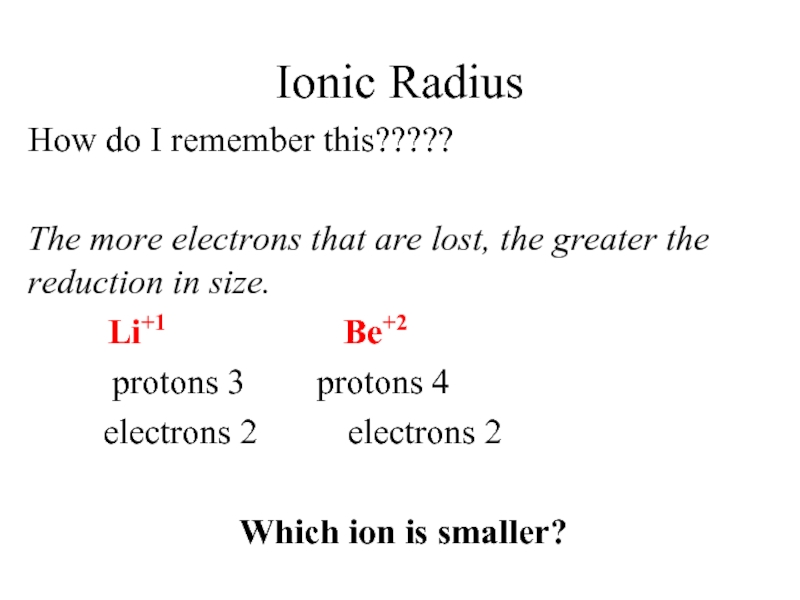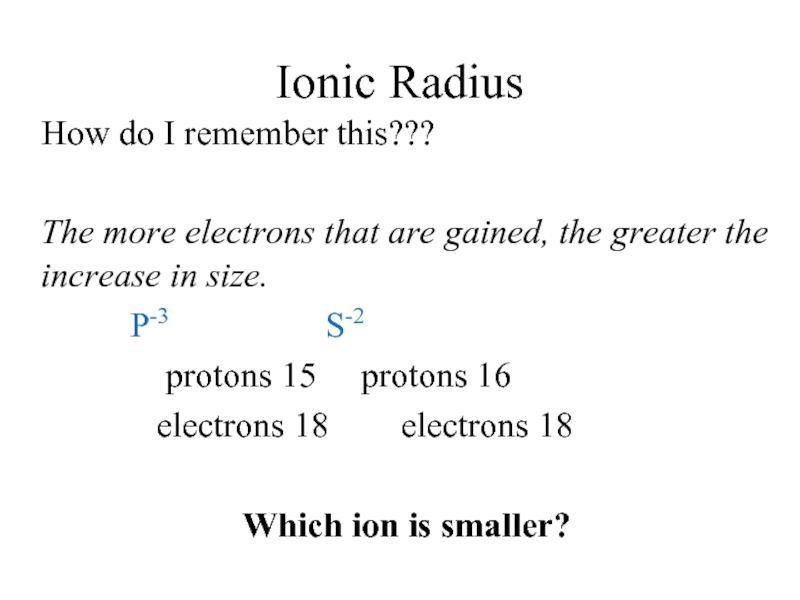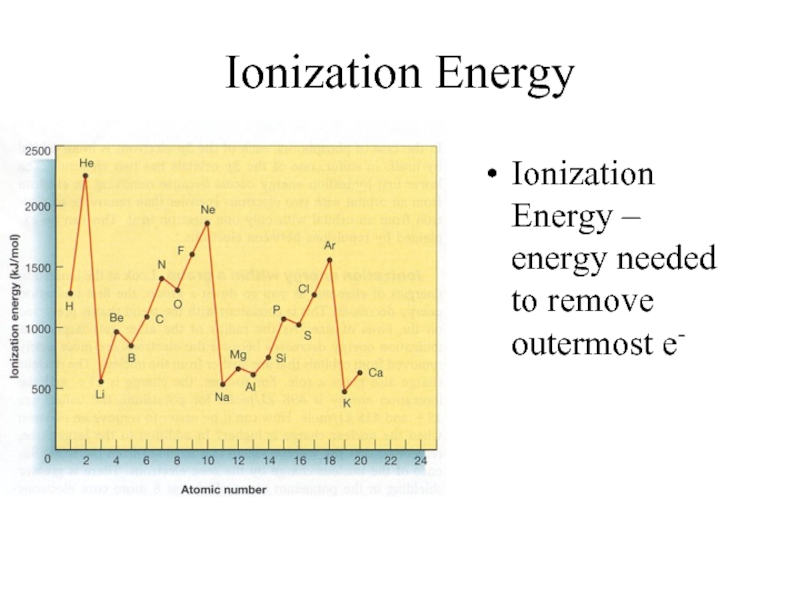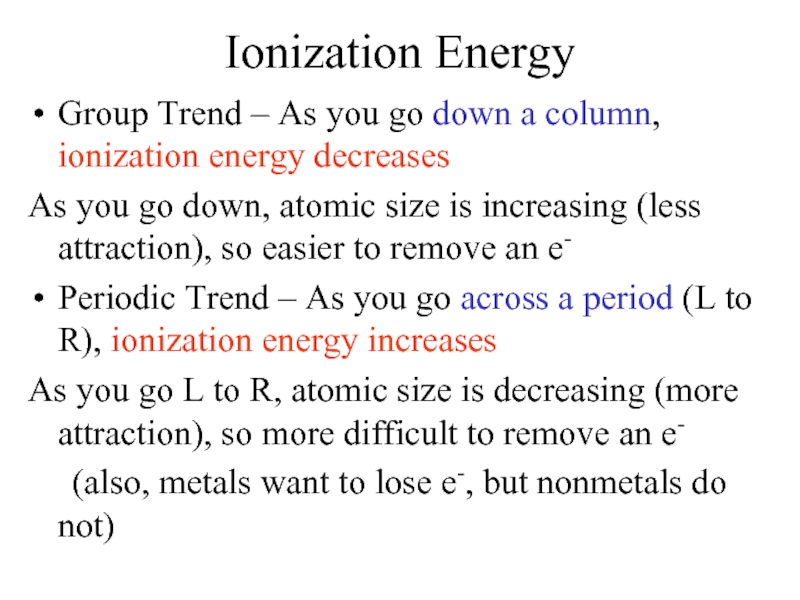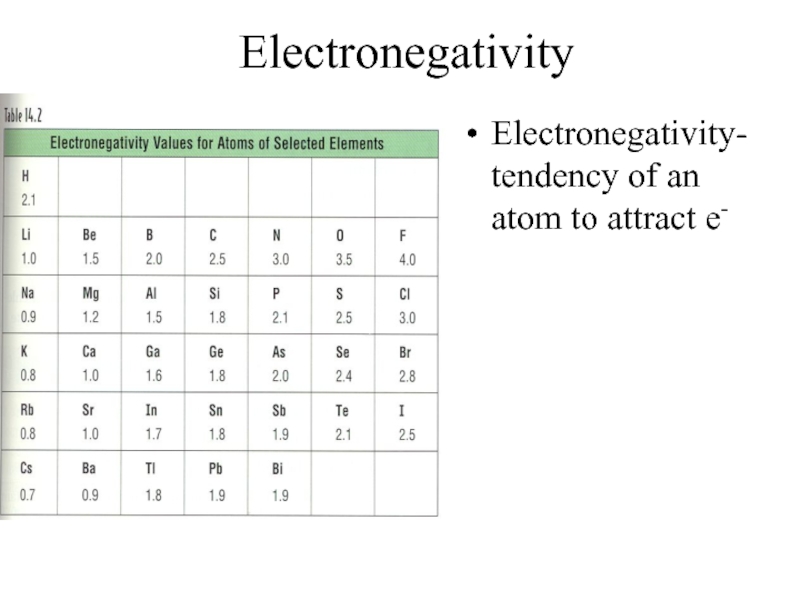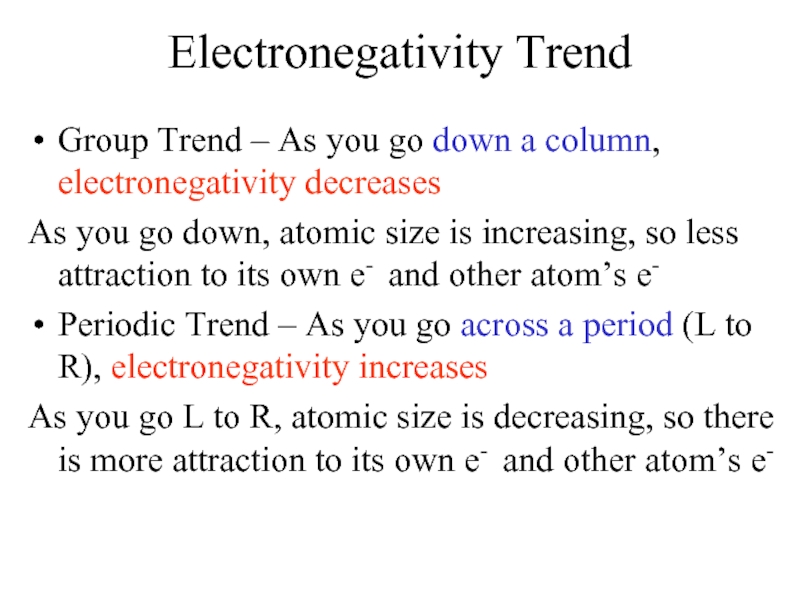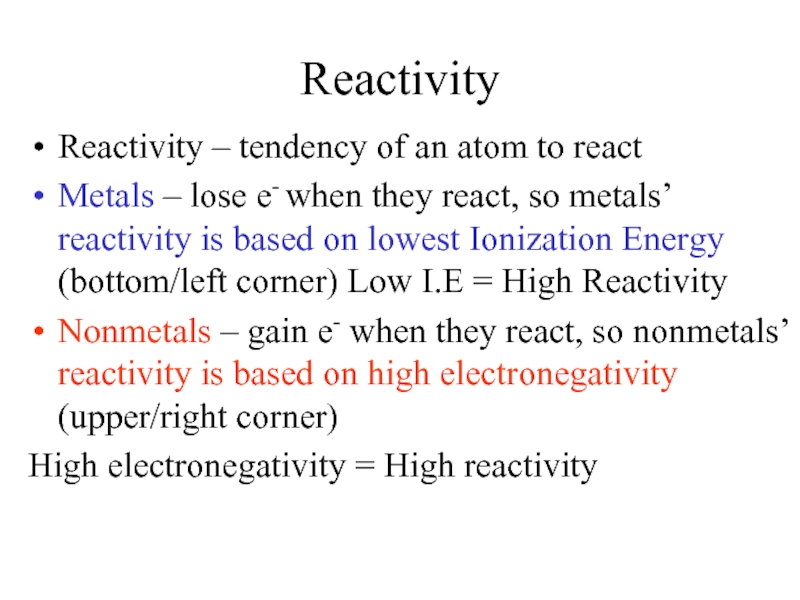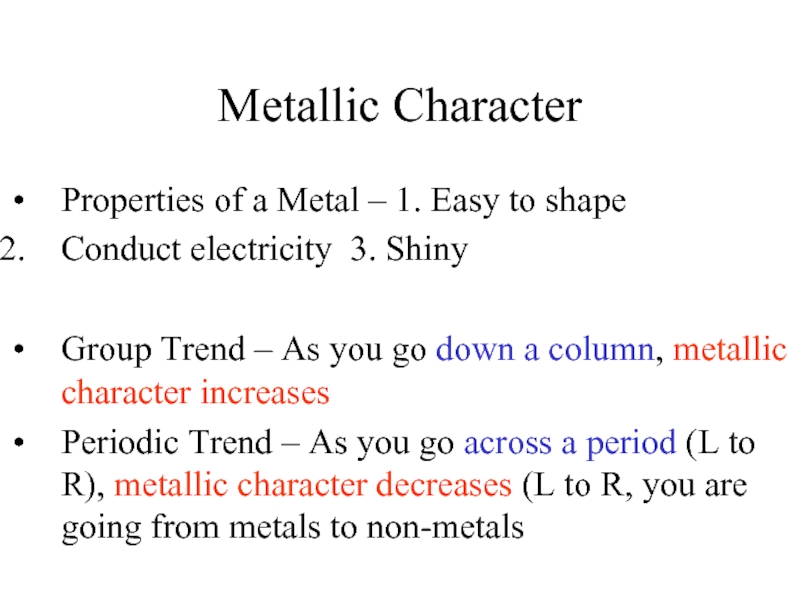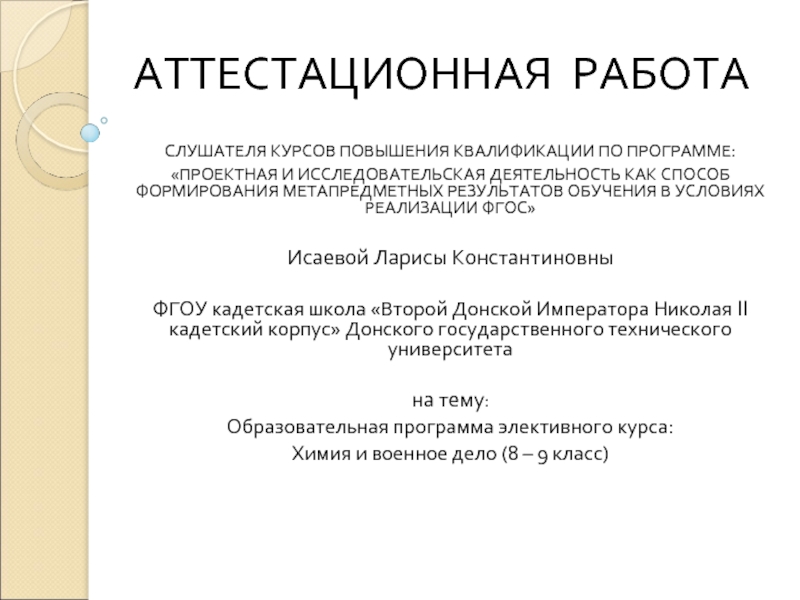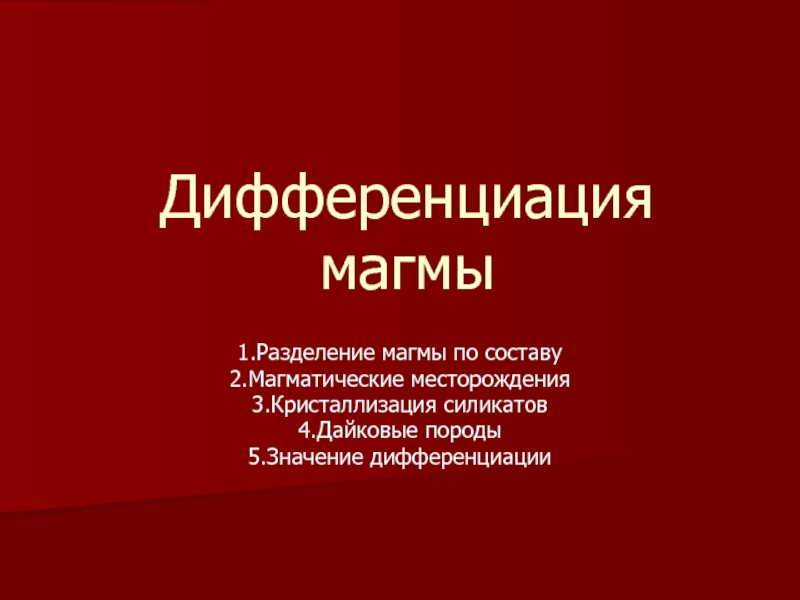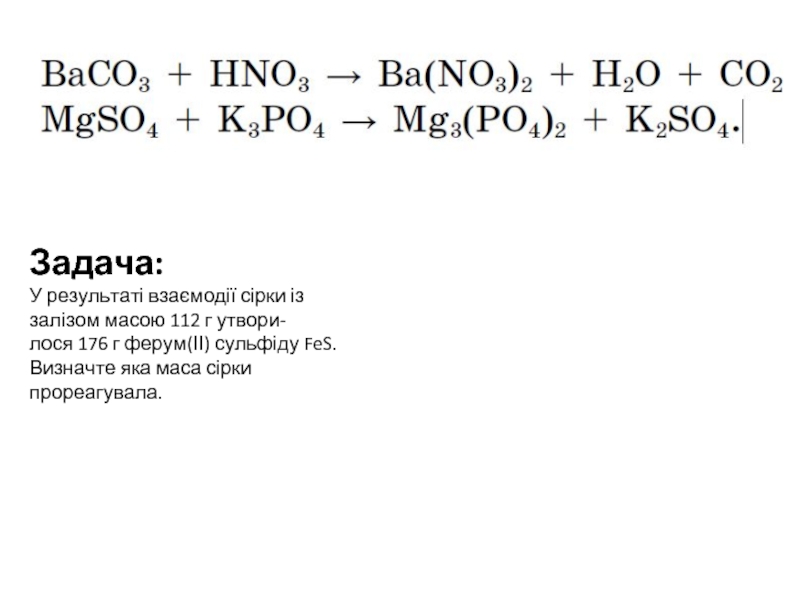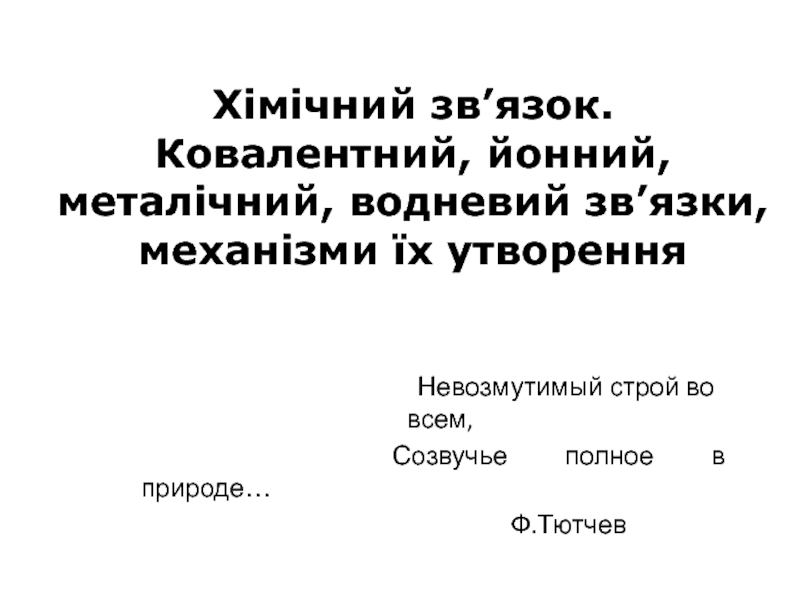- Главная
- Разное
- Дизайн
- Бизнес и предпринимательство
- Аналитика
- Образование
- Развлечения
- Красота и здоровье
- Финансы
- Государство
- Путешествия
- Спорт
- Недвижимость
- Армия
- Графика
- Культурология
- Еда и кулинария
- Лингвистика
- Английский язык
- Астрономия
- Алгебра
- Биология
- География
- Детские презентации
- Информатика
- История
- Литература
- Маркетинг
- Математика
- Медицина
- Менеджмент
- Музыка
- МХК
- Немецкий язык
- ОБЖ
- Обществознание
- Окружающий мир
- Педагогика
- Русский язык
- Технология
- Физика
- Философия
- Химия
- Шаблоны, картинки для презентаций
- Экология
- Экономика
- Юриспруденция
Periodic Table and Trends презентация
Содержание
- 1. Periodic Table and Trends
- 2. History of the Periodic Table 1871 –
- 3. Group Names
- 4. S & P block – Representative Elements
- 5. Periodic Groups Elements in the same column
- 6. Periodic Trends Periodic Trends – patterns (don’t
- 7. Atomic Radius Atomic Radius – size of
- 8. Atomic Radius Trend Group Trend – As
- 9. Ionic Radius Ionic Radius –
- 10. Ionic Radius Trend Metals – lose e-,
- 11. Ionic Radius Trend Group Trend – As
- 12. Ionic Radius
- 13. Ionic Radius How do I remember this?????
- 14. Ionic Radius How do I remember this???
- 15. Ionization Energy Ionization Energy – energy needed to remove outermost e-
- 16. Ionization Energy Group Trend – As you
- 17. Electronegativity Electronegativity- tendency of an atom to attract e-
- 18. Electronegativity Trend Group Trend – As you
- 19. Reactivity Reactivity – tendency of an atom
- 20. Metallic Character Properties of a Metal –
Слайд 2History of the Periodic Table
1871 – Mendeleev arranged the elements according
to: 1. Increasing atomic mass 2. Elements w/ similar properties were put in the same row
1913 – Moseley arranged the elements according to: 1. Increasing atomic number 2. Elements w/ similar properties were put in the same column
1913 – Moseley arranged the elements according to: 1. Increasing atomic number 2. Elements w/ similar properties were put in the same column
Слайд 4S & P block – Representative Elements
Metalloids (Semimetals, Semiconductors) – B,Si,
Ge, As, Sb, Te (properties of both metals & nonmetals)
Columns – groups or families Rows - periods
Columns – groups or families Rows - periods
METALS
TRANSITION METALS
NONMETALS
Слайд 5Periodic Groups
Elements in the same column have similar chemical and physical
properties
These similarities are observed because elements in a column have similar e- configurations (same amount of electrons in outermost shell)
These similarities are observed because elements in a column have similar e- configurations (same amount of electrons in outermost shell)
Слайд 6Periodic Trends
Periodic Trends – patterns (don’t always hold true) can be
seen with our current arrangement of the elements (Moseley)
Trends we’ll be looking at:
Atomic Radius
Ionization Energy
3. Electronegativity
Trends we’ll be looking at:
Atomic Radius
Ionization Energy
3. Electronegativity
Слайд 8Atomic Radius Trend
Group Trend – As you go down a column,
atomic radius increases
As you go down, e- are filled into orbitals that are farther away from the nucleus (attraction not as strong)
Periodic Trend – As you go across a period (L to R), atomic radius decreases
As you go L to R, e- are put into the same orbital, but more p+ and e- total (more attraction = smaller size)
As you go down, e- are filled into orbitals that are farther away from the nucleus (attraction not as strong)
Periodic Trend – As you go across a period (L to R), atomic radius decreases
As you go L to R, e- are put into the same orbital, but more p+ and e- total (more attraction = smaller size)
Слайд 10Ionic Radius Trend
Metals – lose e-, which means more p+ than
e- (more attraction) SO…
Cation Radius < Neutral Atomic Radius
Nonmetals – gain e-, which means more e- than p+ (not as much attraction) SO…
Anion Radius > Neutral Atomic Radius
Cation Radius < Neutral Atomic Radius
Nonmetals – gain e-, which means more e- than p+ (not as much attraction) SO…
Anion Radius > Neutral Atomic Radius
Слайд 11Ionic Radius Trend
Group Trend – As you go down a column,
ionic radius increases
Periodic Trend – As you go across a period (L to R), cation radius decreases,
anion radius decreases, too.
As you go L to R, cations have more attraction (smaller size because more p+ than e-). The anions have a larger size than the cations, but also decrease L to R because of less attraction (more e- than p+)
Periodic Trend – As you go across a period (L to R), cation radius decreases,
anion radius decreases, too.
As you go L to R, cations have more attraction (smaller size because more p+ than e-). The anions have a larger size than the cations, but also decrease L to R because of less attraction (more e- than p+)
Слайд 13Ionic Radius
How do I remember this?????
The more electrons that are lost,
the greater the reduction in size.
Li+1 Be+2
protons 3 protons 4
electrons 2 electrons 2
Which ion is smaller?
Li+1 Be+2
protons 3 protons 4
electrons 2 electrons 2
Which ion is smaller?
Слайд 14Ionic Radius
How do I remember this???
The more electrons that are gained,
the greater the increase in size.
P-3 S-2
protons 15 protons 16
electrons 18 electrons 18
Which ion is smaller?
P-3 S-2
protons 15 protons 16
electrons 18 electrons 18
Which ion is smaller?
Слайд 16Ionization Energy
Group Trend – As you go down a column, ionization
energy decreases
As you go down, atomic size is increasing (less attraction), so easier to remove an e-
Periodic Trend – As you go across a period (L to R), ionization energy increases
As you go L to R, atomic size is decreasing (more attraction), so more difficult to remove an e-
(also, metals want to lose e-, but nonmetals do not)
As you go down, atomic size is increasing (less attraction), so easier to remove an e-
Periodic Trend – As you go across a period (L to R), ionization energy increases
As you go L to R, atomic size is decreasing (more attraction), so more difficult to remove an e-
(also, metals want to lose e-, but nonmetals do not)
Слайд 18Electronegativity Trend
Group Trend – As you go down a column, electronegativity
decreases
As you go down, atomic size is increasing, so less attraction to its own e- and other atom’s e-
Periodic Trend – As you go across a period (L to R), electronegativity increases
As you go L to R, atomic size is decreasing, so there is more attraction to its own e- and other atom’s e-
As you go down, atomic size is increasing, so less attraction to its own e- and other atom’s e-
Periodic Trend – As you go across a period (L to R), electronegativity increases
As you go L to R, atomic size is decreasing, so there is more attraction to its own e- and other atom’s e-
Слайд 19Reactivity
Reactivity – tendency of an atom to react
Metals – lose e-
when they react, so metals’ reactivity is based on lowest Ionization Energy (bottom/left corner) Low I.E = High Reactivity
Nonmetals – gain e- when they react, so nonmetals’ reactivity is based on high electronegativity (upper/right corner)
High electronegativity = High reactivity
Nonmetals – gain e- when they react, so nonmetals’ reactivity is based on high electronegativity (upper/right corner)
High electronegativity = High reactivity
Слайд 20Metallic Character
Properties of a Metal – 1. Easy to shape
Conduct electricity
3. Shiny
Group Trend – As you go down a column, metallic character increases
Periodic Trend – As you go across a period (L to R), metallic character decreases (L to R, you are going from metals to non-metals
Group Trend – As you go down a column, metallic character increases
Periodic Trend – As you go across a period (L to R), metallic character decreases (L to R, you are going from metals to non-metals
